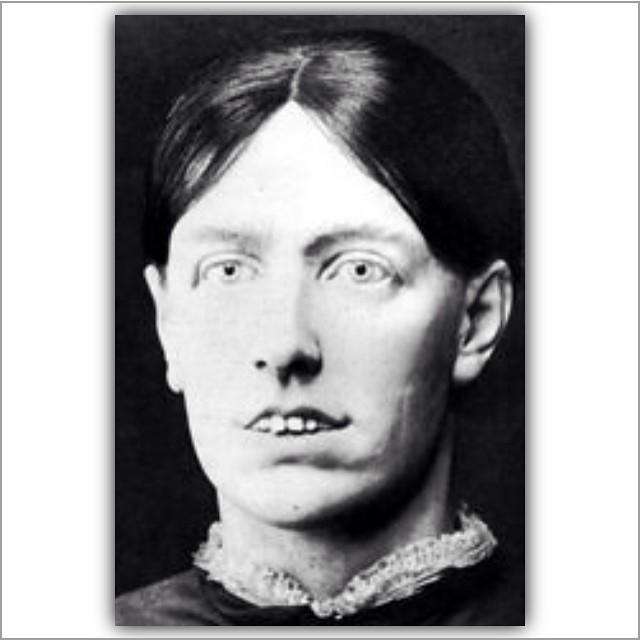The inequality between women and men occupationally, financially, and socially comes as no surprise. But did you know that the biases run deeper than that? When evaluating trends in psychopathy and criminal behavior, both appear to be male-dominated domains. But why? Are women less likely to be psychopaths? Or criminals? That may not be the case. Biases against women in both medical and social realms have affected the number of women who are incarcerated or labeled as “dangerous,” but women can do anything men can do – for better and for worse. And it seems that female psychopaths and criminals do exist, despite the statistics.
In November 1990, a convicted rapist named Richard Mallory was murdered in Volusia County, Florida. He was the first of at least seven men shot to death at point-blank range by Aileen Wuornos, a prostitute who claimed in all the cases that she was acting in self-defense. A jury was unconvinced, and she was executed for the killings in 2002.
Wuornos was probably the most infamous female serial killer in American history. (You might even have seen Charlize Theron’s Oscar-winning portrayal of Wuornos in the film Monster, or one of the documentaries or TV shows based on her story.) But what drove her to a life of prostitution and murder? She was diagnosed with both antisocial personality disorder and borderline personality disorder, but maybe her true diagnosis was one that is relatively uncommon for women – maybe she was a psychopath.

Aileen Wuornos (Credit: Florida Dept. of Correction, via Wikimedia Commons)
Who’s Hysterical? Women Fly Under the Medical Radar
Women have a history of being misdiagnosed and mislabeled. And I mean a long history. Don’t believe me? Let’s go all the way back to the ancient Greeks.
Hysteria: Have you heard of it? It was the first mental disorder attributed to women, and only women. In fact, Hippocrates – the 5th century BCE physician – coined the term “hysteria” from the Greek word “hystera,” or uterus. Across 2,500+ years of history, the “disease” was studied and diagnosed in both scientific and demonological realms. It was “cured” with herbs, sex, or abstinence; punished and purified; and, eventually, clinically studied. The term hysteria served as a catch-all for symptoms like nervousness, hallucinations, and emotional outbursts. If it sounds pretty archaic, think again – it wasn’t until the early 1950s that the American Psychiatric Association (APA) finally dropped “hysteria” as a valid diagnostic term.
We may have moved past the diagnosis of hysteria, but the bias remains. Even in our time, I’ve heard men brush women off because it’s “their time of the month,” or “you know, women just get crazy sometimes.” Such remarks are frustrating enough, but the biases underlying them don’t exist only inside someone’s insensitive remarks – they soak in much deeper.
In recent years, a large number of studies and articles have been published that shed light on an alarming trend: A woman’s pain or illness is taken less seriously than a man’s. For example, it’s been shown that both doctors and nurses prescribe less pain medication to women than men after surgery, despite women asking; and a study conducted by the University of Pennsylvania found that women waited 16 minutes longer than men to receive pain medication in the emergency room. And still, to this day, women are being told that their issues or illnesses are stress-related or imagined … which sounds a lot like that ol’ hysteria diagnosis again.
Psychopath: A Man’s Disease?
If you are looking for an example of how gender biases continue to taint psychological diagnoses today, there's no clearer case than that of the psychopath.
Psychopaths are distinguished by specific traits and behaviors, and typically experience a lack of emotions, guilt, and empathy, have an inability to form true emotional attachments, are dishonest despite being successful, and exhibit manipulative behavior, narcissism, and superficial charm. According to most studies, about one in 100 people fit the description of a psychopath – and, until recently, women were rarely diagnosed with the disorder. In fact, only 0.3%–0.7% of women are. But can that tiny number really be true?
RECOMMENDED READING: Psychopath Or Sociopath: What’s The Difference?
Past research suggests that men are more prone to psychopathy than women, but that may not be the case. Researchers are now finding that diagnostic tools might not be adequate for evaluating both men and women and could be the reason why we typically see more psychopathic men. In any case, just because psychopathy has been thought mostly to affect males, it doesn’t mean female psychopaths do not exist. Perhaps they’ve just gone unnoticed or undiagnosed.

Ted Bundy (Credit: Don Dughi/Florida Memory Project, via Wikimedia Commons)
Female psychopaths might have flown under the radar because of different behavioral traits exhibited by men and women. For example, one of the most obvious markers of this atypical behavior is superficial charm and a grandiose self-image – two traits that do not usually occur in female psychopaths. And while the data on particularly high-risk females reveals similar traits to the average male psychopath in unemotional behavior and conduct, it is possible many women are going undiagnosed because of how they score on psychological testing: Female psychopaths tend to score better on emotional intelligence tests than males, allowing them to dodge the “psychopath” label.
In addition, antisocial behavior develops differently in young men and women. Early indicators for young men include acting out with criminal tendencies, rule violations, aggression, and violence. On the other hand, jealousy, self-harm, manipulation, and verbal aggression are predictors of psychopathic development in young women.
According to a 2015 study evaluated by Psychology Today, females tended to exhibit more of the interpersonal and lifestyle facets of psychopathy (manipulativeness, grandiosity, and impulsivity) than the emotional and antisocial facets (lack of remorse and delinquency).
In addition to exhibiting different symptoms from men, it’s also possible that women psychopaths have been misdiagnosed with borderline personality disorder (BPD) – a disorder most typically associated with women in a 3:1 female to male ratio. BPD and psychopathy overlap in behaviors and traits, and it’s possible that psychopathic women are misdiagnosed with BPD because of those similarities. Carefully differentiating between the two disorders might just balance the scale – evening the statistical gap between male and female psychopaths (and, potentially, shrinking the proportion of female vs male cases of BPD).
While female and male psychopaths may behave differently, the cause typically tends to be the same. Researchers believe that psychopathy is a neurodevelopmental disorder, and is related to the functionality of the individual’s brain. While the exact causes of psychopathy are still being explored, studies have shown dysfunctions in the brain’s amygdala and the ventromedial frontal cortex. In fact, it’s been shown that a psychopath’s amygdala is up to 18% smaller than normal.
Do Fewer Women in Prisons Skew the Data?
There is a large, undeniable gender gap within U.S. federal prisons. According to the Federal Bureau of Prisons, currently 92.9% of inmates are male. The remaining 7.1% are female. But it’s not necessarily factual that men are more likely than women to become criminals. It’s probably … drum roll … just another institutional bias.
Researchers and scholars have been curious about this apparent gap and have investigated further. Studies revealed that men are more likely to be sentenced to prison – and for much longer – than females who are arrested.
But what does this have to do with psychopaths? Well, psychopaths are thought to be responsible for over half of all serious crime. In fact, 25-30% of male prisoners qualify for the psychopath diagnosis, but it’s estimated that only 11-17% of the female prison population is made up of psychopaths. If a large portion of serious offenders are considered to be psychopathic, why don’t the numbers reflect that reality among female inmates?

Female inmates in a prison classroom (Credit: U.S. Dept. of Justice, Bureau of Prisons, via Wikimedia Commons)
Statistically speaking, women and men tend to engage in different types of crime. Women are more likely to commit theft or fraud, for example, while men’s criminal behaviors often include violence. But these distinctions don’t always hold, and female criminals and psychopaths can be dangerous as well.
Female psychopaths, in fact, commit crimes that stretch across multiple categories – and robbery, drug-related crimes, and assaults are not out of the ordinary. These offenders are often motivated by power, dominance, or personal gain, and they are more likely to repeat-offend than the non-psychopathic inmates.
So why are there so many fewer female psychopaths in prison than their male counterparts? While some may take this as evidence that fewer women are psychopaths, that may not be a fair assumption. Because female psychopaths tend to be more verbally aggressive than physically violent, it’s likely they commit fewer violent crimes than male psychopaths, resulting in a smaller population of incarcerated women psychopaths. Whether it be the types of crimes committed, the lower number of imprisonments, or the lack of diagnoses among the female population, women – and women psychopaths – don’t seem to be showing up in the data.
But just because there are fewer of them, doesn’t mean they don’t exist. . . .
Women Criminals and Psychopaths
As the story of Aileen Wuornos makes clear, female psychopaths exist among us. And she’s far from the only one. Take Belle Gunness, for instance. Gunness, a late 19th century villain, left a trail of bodies behind her, and was suspected of murdering countless victims, including her own children and husbands. This suspicion was confirmed by the remains of over 40 bodies found on her property. Despite the overwhelming evidence, she was never caught. She disappeared without a trace in 1908.
Heck, some even speculate that Jack the Ripper was actually a woman. Their suspect is the Victorian killer, Mary Pearcey, who, in 1890, was convicted of the murder of her lover’s wife and child.

Mary Pearcey (Public Domain)
Of course, pop culture is full of dangerous women, and the femme fatale has graced and charmed her way onto our screens. The dangerous woman is sexy, empowering, and scary, all at the same time. Characters like Amy Dunne from Gone Girl or Glenn Close’s Alex Forrest in Fatal Attraction show us how cunning and dangerous the woman psychopath can be. And the portrayal of Lisa, a girl with borderline personality disorder played by Angelina Jolie in Girl, Interrupted, provides a good look into how similar BPD is to psychopathy.
Female psychopaths and criminals are out there, but social biases and gender inequalities have allowed them to go mostly undiagnosed and unnoticed. In this way, perhaps, we see the flip side of the effect of gender biases. On the one hand, those biases stand in the way of women’s aspirations; on the other, women are strangely thought to be unequal to men even in ways that can be socially destructive. But we’re all human after all – for better and for worse – and calling attention to this will help close the gap between men and women.
Ω
Title image: Female prisoners by Framestock via Adobe Stock.

